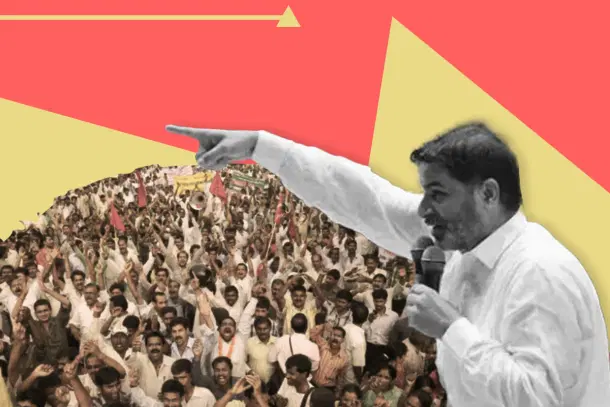Politics
Prashant Kishor’s Promise Of Change: How Jan Suraaj Plans To Rewrite Bihar’s Political Script
Adarsh Pandit
Sep 30, 2024, 07:14 PM | Updated Oct 03, 2024, 11:13 PM IST
Save & read from anywhere!
Bookmark stories for easy access on any device or the Swarajya app.


Bihar has long been recognised as a hotbed of Indian politics. From the 1960s until 1989, the state saw as many as 23 chief ministers, creating a climate of instability that left the public feeling helpless. The messy grammar of caste politics solidified with various power centres involved in this constant push and pull.
The question finally settled when Lalu Prasad Yadav became the state chief minister (CM). Slowly, over the next three decades, certain structures emerged as the permanent praxis of Bihar’s politics.
To put it bluntly, it was an M-Y (Muslim-Yadav) combination for RJD, and in return, a counter-polarisation of ‘upper castes,’ Kurmi, the extremely backward class (EBC), and Dalits in favour of the National Democratic Alliance (NDA).
Since then, the politics of Bihar has remained largely stagnant, with only marginal changes. Discussions arise and ferment out of these equations alone.
At this juncture, poll strategist Prashant Kishor entered the fray as a politician in the state. He claims to have conducted a thorough survey wherein 80 per cent of respondents agreed to seek a better alternative, having ‘lost faith in the present political dispensations operating in the state.’
This sentiment sparked the idea to present an alternative to the public. Kishor started with his padyatra — a tried and tested tool for engagement — on 2 October 2022 to connect with the people and change his tonality to immerse himself in the grind. As time passes, it’s essential to sincerely examine what he is offering to the people of Bihar.
In his recent address to the gathering of young volunteers of Jan Suraaj in Patna, Kishor said, “Ye aakhiri peedhi hai Bihar ki jisko majboori me majdoori karne ke liye Bihar se bahar jana pada hai (this is the last generation of Bihar that is forced to leave the state to earn a livelihood as daily wage labourers).”
He implied that once Jan Suraaj is in power, employment opportunities will be available within the state. This sums up the story of Bihar, and, in a way, the agenda of Jan Suraaj.
Two years ago, when Kishor first began his padyatra in Bihar, people did not take him seriously. Having witnessed various similar campaigns, they dismissed it as a mere gimmick. However, over the last 24 months, the scale, determination, and effort behind the Jan Suraaj padyatra have established the party as a new axis in Bihar’s politics. Its imprint is now undeniable.
Political leaders who never responded to Prashant Kishor’s criticism seem to have become vocal now. Although, local newspapers deny the prominence of Jan Suraaj by often overlooking its news, social and digital media buzz with narratives surrounding Kishor.
He is compelling leaders across party lines to engage in substantive discussions that have been absent from Bihar’s political discourse for too long, a landscape traditionally dominated by rhetoric. Kishor has been trying to capture this very fatigue.
It’s too early to pass any judgement on how much electoral impact Jan Suraaj will have on the politics of Bihar. The party has yet to take shape and declare its vision and mission.
But given the claims and campaigns of Kishor, we can glean the drift of his direction. His party is setting up the narrative and trying to reach out to a few specific sections to woo them in their favour.
Firstly, Jan Suraaj aims to attract women voters, who have largely supported Nitish Kumar and the NDA since 2005 due to improvements in law and order. The pitch is quite simple and emotional.
The grim reality of Bihar is that you will find almost no youngsters in villages. They have all left home to earn a livelihood. Many become daily wage labourers, while others find employment in formal sectors, leaving their elderly parents and, in many cases, their wives behind. These women await their return each year for Diwali and Chhath.
While there is no formal study on the mental and emotional toll of such large-scale migration on the minds of parents or spouses left behind, anyone who knows Bihar knows that this is a common experience.
Jan Suraaj claims it can reverse this distress migration. In his message, Kishor says no one will be forced to leave the state again once they return for the next Chhath Puja (in 2025). Using cultural motifs to push the message of economic distress is a time-tested tactic in politics. He is using the same in Bihar.
If there is any significant movement in the women voter base, it will have a disastrous effect on the winning chances of NDA. Women have till now stood solidly behind the NDA in Bihar. It will be interesting to witness how much success Jan Suraaj gets in this particular section.
The second target voter base Jan Suraaj is trying hard to woo is the youth. Bihar is going through a unique phase where more than 70 per cent of people are under 35.
We must remember the 2014 Lok Sabha election where Narendra Modi got elected as the prime minister with a complete majority. India, being a young country, wanted decisive leadership, and Modi captured this imagination. Bihar is even younger than the India of 2014. This young population is much more vocal and informed through social media.
Kishor is keenly focused on this voter base, heavily investing in social media and employing paid volunteers in each block of the state. As a political newcomer, he feels free to critique the current political landscape across all parties.
His promise to bring ordinary individuals into politics is particularly to move young voters to his side. Kishor claims that only about 1,200 families have held political power in Bihar for the last 40 years, urging a shift towards new, well-meaning candidates.
His platform aims to align with the aspirations of the youth, bolstered by the joinings of respected figures such as former top cop Anand Mishra, mathematician K C Sinha, and other intellectuals the youth look up to.
Moreover, subtle endorsements by actors Manoj Bajpai and Pankaj Tripathi and educationists like ‘Khan sir’ also add to the credibility of the platform (Jan Suraaj).
Even a slight shift among this youth base could lead to significant electoral gains for Jan Suraaj, making them a formidable opponent to both the NDA and the INDI Alliance. As of now, in substance and freshness, which generally appeals to the youth, Jan Suraaj is far ahead of the existing political outfits of the state.
Both women and youth can help Jan Suraaj move beyond the existing caste calculus of politics in Bihar. Additionally, Kishor is also focusing on the Muslim vote bank.
His message for Muslims is to move on from the fear of the BJP and vote for their own economic upliftment. He is actively engaging with the Seemanchal belt of Bihar, where Muslim voters are concentrated, attempting to forge alliances with local Maulvis and intellectuals from the Muslim society.
For context, approximately 75 out of 243 Vidhan Sabha (legislative assembly) seats in Bihar have more than 30 per cent combined Muslim and Yadav voters. If Muslim votes move, it will be a huge blow to the INDI alliance.
A small but interesting recent development is Tejashwi Yadav taking out his own yatra and meeting party cadres. During his visit to Muzaffarpur, the former deputy CM spoke in an interview with a digital portal. The interview was in Hindi, but quite unlike Tejashwi, he spoke in polished English for around 20-25 per cent of the interview. Is he attempting to counter Kishor's critiques regarding his educational background and present himself as a more educated leader who knows what he is doing?
For now, Kishor and his political outfit will be closely watched. He promises to bring about 1 crore people to establish his political party on 2 October. If successful, this could position the party as a significant player in Bihar's political arena. It remains to be seen how the BJP, JDU, and RJD will respond to the grassroots momentum of Jan Suraaj in the state. Bihar will go through tumultuous and interesting times ahead.





